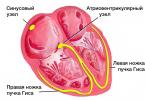0 rated
Popular per person!
Monument to the truck GAZ-AA installed in front of the main entrance GAZ.

The car was installed on a pedestal at the main entrance in 1982 in honor of the 50th anniversary of the Gorky Automobile Plant. The monument bears the inscription: The memorial sign of the labor glory of car factory workers was laid on April 17, 1982 - the year of the fiftieth anniversary Gorky Automobile Plant .
History of GAZ-AA

GAZ-AA, NAZ-AA or lorry- legendary freight car Gorky Automobile Plant. GAZ-AA was a many times upgraded licensed copy of the 1930 model AA Ford truck.
The car had a carrying capacity of 1500 kg or one and a half tons, which gave it its name. lorry.
The first "one and a half" GAZ-AA rolled off the assembly line of the Gorky Automobile Plant on January 29, 1932. Then the truck was called NAZ-AA, because Nizhny Novgorod was renamed Gorky a little later.
It was a real breakthrough in the automotive industry: "one and a half" were distinguished by endurance, unpretentiousness, and good performance and what is important for Soviet roads - cross-country ability.
Important role truck GAZ-AA played during the Great Patriotic War and especially - the blockade of Leningrad, providing a connection between the city and the outside world, transporting food and providing evacuation.
A lorry was produced until 1949, after which it gave way to other, more advanced models on the conveyor.
Nizhny Novgorod, Lenin Ave.nearest metro station "Kirovskaya"
In the photo - GAZ main entrance.
The Gorky Automobile Plant is the largest enterprise in the Avtozavodsky district, and probably in the city, too. And the most famous.
And it began in 1930 with a giant construction site. In just 17 months, the construction was basically completed, and by 1932 the plant was put into operation operating enterprises.

On January 29, 1932, the first GAZ-AA truck was assembled on the main conveyor of the automobile plant. More precisely, NAZ-AA, because Nizhny was renamed Gorky a little later.

On it was installed four-cylinder engine with a capacity of 42 liters. With. Due to the low compression ratio of only 4.25, low-octane gasoline was used as fuel, which was very important at that time.
The fact is that high-octane fuel Soviet factories haven't done it yet. And GAZ-AA could drive even on kerosene, even on tractor naphtha.

The power reserve was 215 km. Car carrying capacity - one and a half tons. Therefore, they called the car "one and a half".

GAZ-AA and its modified version GAZ-MM went through the Great Patriotic War and were produced at the car factory until 1949. And in total, almost a million of them were produced by all factories (985 thousand pieces).

In honor of the 50th anniversary of GAZ, it was decided to lay out a square at the main entrance and install a memorial sign of the labor glory of the car factory workers. The workers proposed to install a GAZ-AA truck on a pedestal.
On the side of the monument it is written: "The memorial sign of the labor glory of the automobile plant workers was laid on April 17, 1982 - the year of the fiftieth anniversary of the Gorky Automobile Plant."

Nothing has changed in the park since then. The mosaic panels about the history of the plant, which are shown in the photo above, are still pleasing to the eye. Vladimir Ilyich is still in a hurry to leave the factory (he stands symmetrically to the car, but on the other side of the square).
Only changed opposite side avenue Lenina. Now the workers, having passed through the square and crossed the road, will find themselves in a large hypermarket "Okay". And this is probably convenient and good.
The history of GAZ begins at the end of the twenties of the last century. In March 1929, the council National economy Soviet Union a decree is signed on the start of construction of a new one in the nearest location from Nizhny Novgorod. Construction began in early May 1930. In connection with the settlement formed near the new building in 1931, the Avtozavodsky district was created, and by January 1, 1932, the GAZ was built.
checkpoint car factory GAS
But at first it was called the Nizhny Novgorod Automobile Plant. Molotov.
The prototype of the first Nizhny Novgorod cars were american cars Ford. The GAZ A passenger car was developed on the basis of Ford A, the American truck Ford AA was taken as the basis (lorry). The cars were similar to the "Americans", but still had their own outlines - the head of the Nizhny Novgorod design group to make their own adjustments in the development of projects.
In October, Nizhny Novgorod is renamed Gorky, then it changes its name and the automobile plant - it becomes Gorky.

Assembly shop of the Gorky Automobile Plant
GAZ is rapidly gaining momentum - in 1933, the GAZ 03 30 bus was developed and launched into series. Almost simultaneously, a pickup truck was created on the basis of GAZ A, the metal body of which is capable of carrying loads of up to 500 kg.
On the next year 3-axle GAS AAA appears. In 1935, GAZ had already produced 100,000 vehicles, and this event was an important date in the history of the plant.
In 1936, the plant begins to produce. The "black funnel" is based on the "Ford" model V8-40. This machine was produced in the first war years, its production was discontinued in 1943. On the basis of GAZ M1 is created new model GAZ 11 73, on which the GAZ 11 engine was installed. This engine has a long history - in the future it was equipped with a well-known one.

Conveyor for the production of engines for GAZ trucks
By the beginning of the Great Patriotic War, the GAZ plant had mastered about two dozen various modifications and produced almost half a million cars various types. 70 percent of all cars produced in the Soviet Union before the war accounted for the Gorky Automobile Plant.

It looks like the Volga model 31105
But this time on the assembly line, she did not last long - in 2009 assembly line"Volga" completely turned off. There was another attempt to put the Volga Cyber on stream, but this project failed, having existed for about a year.



